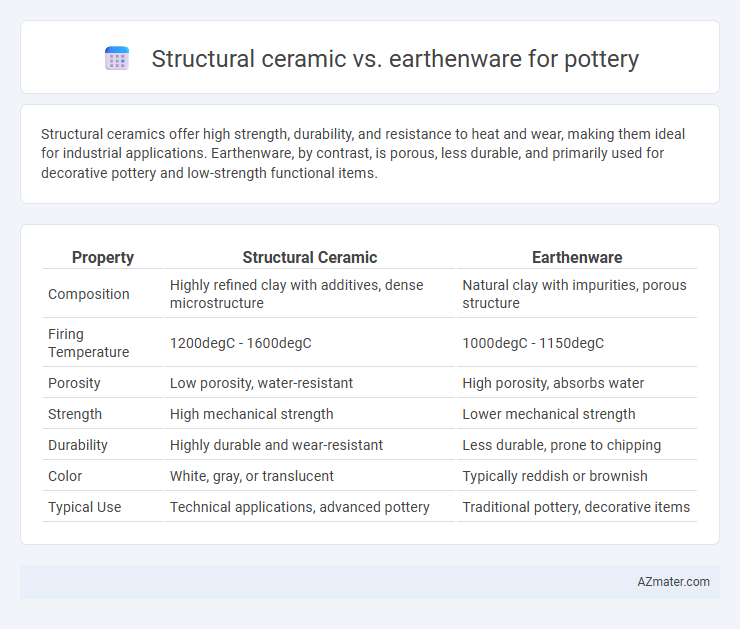Structural ceramics offer high strength, durability, and resistance to heat and wear, making them ideal for industrial applications. Earthenware, by contrast, is porous, less durable, and primarily used for decorative pottery and low-strength functional items.
Table of Comparison
| Property | Structural Ceramic | Earthenware |
|---|---|---|
| Composition | Highly refined clay with additives, dense microstructure | Natural clay with impurities, porous structure |
| Firing Temperature | 1200degC - 1600degC | 1000degC - 1150degC |
| Porosity | Low porosity, water-resistant | High porosity, absorbs water |
| Strength | High mechanical strength | Lower mechanical strength |
| Durability | Highly durable and wear-resistant | Less durable, prone to chipping |
| Color | White, gray, or translucent | Typically reddish or brownish |
| Typical Use | Technical applications, advanced pottery | Traditional pottery, decorative items |
Introduction to Structural Ceramics and Earthenware
Structural ceramics, known for their high strength, durability, and resistance to heat, are engineered materials commonly used in industrial applications and advanced pottery techniques. Earthenware, a traditional pottery material, is characterized by its porous nature, lower firing temperature, and distinctive rustic appearance, making it suitable for decorative and functional pottery. The key difference lies in structural ceramics' enhanced mechanical properties versus earthenware's accessibility and ease of shaping.
Composition and Raw Materials
Structural ceramics primarily consist of high-purity alumina, silicon carbide, and zirconia, offering enhanced mechanical strength and thermal resistance. Earthenware is composed mainly of clay minerals, including kaolinite, ball clay, and feldspar, with a high content of iron oxide that gives it its characteristic reddish color. The raw materials for structural ceramics undergo extensive refining and processing for performance optimization, whereas earthenware relies on more natural, minimally processed clays.
Firing Temperatures and Techniques
Structural ceramics require firing temperatures typically between 1,200degC and 1,400degC, resulting in a dense, vitrified body ideal for mechanical strength and durability. Earthenware is fired at lower temperatures, usually between 1,000degC and 1,150degC, producing a porous and less dense material that remains more fragile and requires glazing for waterproofing. The firing techniques for structural ceramics often involve controlled kiln atmospheres and longer firing cycles to ensure uniform vitrification, whereas earthenware firing is generally faster, often using traditional pit firing or simple kilns.
Mechanical Strength and Durability
Structural ceramics exhibit higher mechanical strength and significantly greater durability compared to earthenware, making them ideal for load-bearing applications. Earthenware, characterized by its porous nature and lower firing temperature, typically lacks the robustness required for heavy-duty use and is prone to chipping and weathering. The dense microstructure and vitrification in structural ceramics result in superior hardness, resistance to fracture, and long-term stability under mechanical stress.
Water Absorption and Porosity
Structural ceramics exhibit significantly lower water absorption rates, typically below 1%, due to their dense microstructure and minimal porosity, making them ideal for applications requiring high strength and durability. In contrast, earthenware has higher porosity, often ranging between 5% to 15%, which results in greater water absorption and lower mechanical strength, limiting its use in utilitarian pottery exposed to moisture. Optimizing the clay composition and firing temperature can reduce earthenware porosity but it generally cannot match the impermeability and structural integrity of high-fired structural ceramics.
Artistic Potential and Surface Finishes
Structural ceramic offers superior strength and durability, allowing artists to create intricate, large-scale pottery with precise, sharp details that maintain form over time. Earthenware's porous nature and warm, earthy tones provide a unique surface texture that enhances rustic, organic finishes, making it ideal for hand-painted glazes and matte effects. The choice between structural ceramics and earthenware significantly impacts the artistic potential, influencing both the complexity of design and the variety of surface finishes achievable in pottery.
Common Uses in Pottery
Structural ceramics are primarily used in pottery for functional items requiring high durability and resistance to heat, such as kiln furniture, industrial components, and technical ceramics. Earthenware, on the other hand, is widely utilized for decorative pottery, everyday tableware, and flower pots due to its porous nature and lower firing temperature. The choice between structural ceramic and earthenware depends on the desired strength, porosity, and thermal properties for specific pottery applications.
Environmental Impact and Sustainability
Structural ceramics exhibit higher durability and thermal resistance compared to earthenware, resulting in longer product lifecycles and reduced material waste. Earthenware, fired at lower temperatures, consumes less energy during production but tends to be less durable and more prone to chipping, leading to frequent replacements and increased environmental burden. Sustainable pottery practices favor structural ceramics for their longevity despite higher initial energy use, while earthenware offers eco-friendliness through lower firing emissions and the potential for local sourcing of raw materials.
Cost and Accessibility for Potters
Structural ceramics typically involve advanced materials like alumina or silicon carbide, making them more costly and less accessible for hobbyist potters due to specialized kiln requirements and raw material expenses. Earthenware, made from natural clays such as red or white clay, offers an affordable and widely available option with lower firing temperatures suitable for amateur and professional potters alike. The cost-effectiveness and accessibility of earthenware make it the preferred choice for everyday pottery, while structural ceramics are reserved for high-performance or technical applications.
Choosing the Right Material for Your Pottery Project
Structural ceramics offer high strength, durability, and thermal resistance, making them ideal for functional pottery that requires longevity and mechanical stability. Earthenware, characterized by its porous nature and lower firing temperatures, is suited for decorative pieces and projects where ease of shaping and vibrant glaze application matter more than durability. Selecting the right material depends on the desired balance between mechanical performance and aesthetic qualities in your pottery project.

Infographic: Structural ceramic vs Earthenware for Pottery
 azmater.com
azmater.com